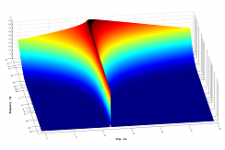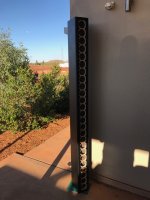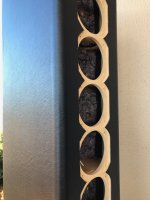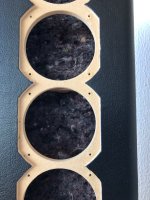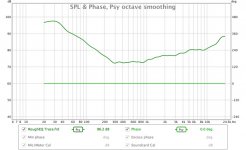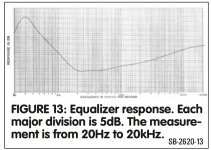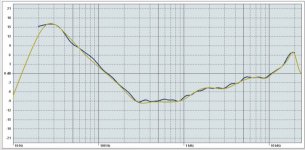...couldn't resist a little bit of branding...
Understandable
Attachments
+1 Fluid, you're doing a fine job on those arrays.That base looks really slick! Nice work!
Thanks, I don't have any hopes of achieving quite the same as wesayso, at least in the short to medium term there won't be any acoustic treatment so the result will be entirely down to directivity, placement and careful EQ. I still think that the design offers enough benefits over a conventional speaker to make it worthwhile. I want to see if I can get some good outdoor measurements when I am finished as they will be easier to achieve than indoor ones at any reasonable volume for now. A 4 month old and an open plan house aren't a good combination for 100dB test tone sweepsUnderstandablebe proud of your work it looks so great and really pleasure to follow, down the road sound wise also hope for you get them to couple as good into room as wesayso did.
That base looks really slick! Nice work!
Hope you find a good recipe to keep the leather look intact.
It pays off to find such recipes in testing.
Sound wise we should be able to get everything to work out.
Thanks, I am more concerned about getting a good bond between the fabric and the MDF as it will be hidden ultimately behind the fabric sock. I suspect that real leather would be better in this respect but the cost rules it out.
I briefly considered going back to paint but I think that having a skin over the whole cabinet will be a benefit and even if I don't get the perfect finish on the fabric it is a better surface to slide the sock over.
I'm sure when I get to measuring that your experience in interpreting the graphs will be very useful if you are willing and have the time available
Thanks! I appreciate all the positive comments+1 Fluid, you're doing a fine job on those arrays.
I have got one tower finished with the leather look fabric. Overall I think it is a success. There are a few defects in the fabric as I bought it quite a long time ago and it has been through a few house moves but as it is not meant to be the final finish that is visible I don't really mind. A lot of work to cut it back to the driver cutouts.
If I was doing this for the final finish then I would have pressed it into the driver cutouts and made them bigger to accommodate, as that looks much neater.
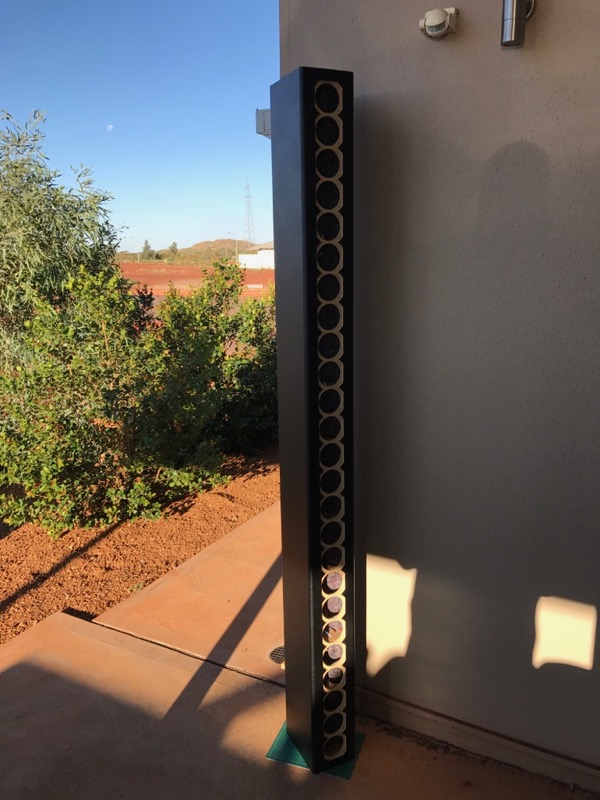
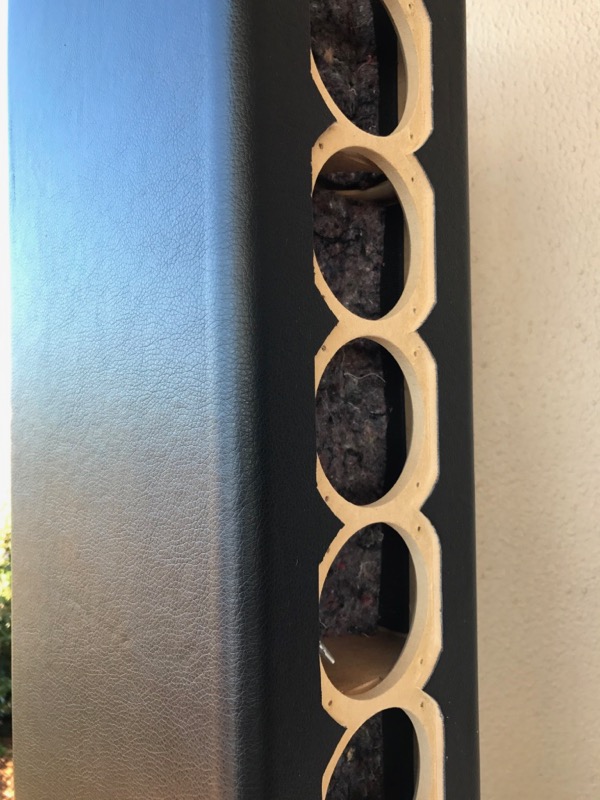
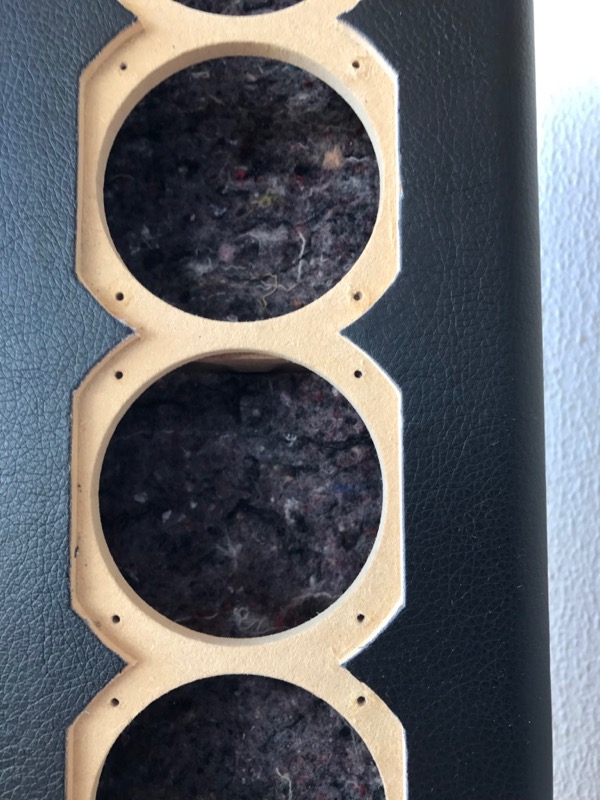
If I was doing this for the final finish then I would have pressed it into the driver cutouts and made them bigger to accommodate, as that looks much neater.
Attachments
If I was doing this for the final finish then I would have pressed it into the driver cutouts and made them bigger to accommodate, as that looks much neater.
What about painting the speaker inlays and front panel black before applying the finish? Since the fabric is also black you would notice the "imperfections" in the cut-out less.
Anyway, they do look very nice from here. Once again nice work.
Looks neat enough Fluid. Well done!
Looks great Fluid.
The kind of project that unspires others to do the same...
Thanks
I'll take that as Inspiring seen as U and I are next to each other on the keyboard
What about painting the speaker inlays and front panel black before applying the finish? Since the fabric is also black you would notice the "imperfections" in the cut-out less.
Anyway, they do look very nice from here. Once again nice work.
It is possible to do that but it wouldn't make any difference in this case. The drivers fit very tightly in the cutout and are level with the height of the fabric so none of the raw MDF is exposed. Because the material has a fabric backing that is white when it is cut you can see the white edges, folding it into the recess would hide that. You could use a black marker to go along the edge afterwards but that's another fiddly job that is just as easy to end up making a bigger mess.
The neatest edge is achieved but cutting a tiny sliver of the MDF at the same time but it is a delicate task to avoid spoiling the CNC cutting job.
Getting closer, still a little way to go yet as I need to test all the drivers and cut the foam tape for all the cutouts as well as apply the fabric to the other tower before the drivers can be screwed and wired in.We are near to getting first sound! Exiting. I can hardly wait.
I would have liked to get the other tower and fabric piece prepared with glue but I ran out as it took significantly more glue than I thought it would.
I am thinking more seriously about a basic EQ strategy to get started with as it won't be too far away before I get to plug them in
I'll take that as Inspiring seen as U and I are next to each other on the keyboard
Blame it on the phone's keyboard!
I am thinking more seriously about a basic EQ strategy to get started with as it won't be too far away before I get to plug them in
If I don't forget I will give you a target for static EQ. That is if you are planning to run the towers about half a meter from the wall. I'll average what I run on both speakers.
If I don't forget I will give you a target for static EQ. That is if you are planning to run the towers about half a meter from the wall. I'll average what I run on both speakers.
Just for informational purposes, the DriveRack PA2 is a nice device that includes EQ. There is also an app to configure the device. If you have a calibrated microphone then you can even measure the response and make adjustments accordingly.
Thanks. There is still felt to go on the front and the drivers with the gaskets on them don't look so nice front mounted so the overall effect will still be better for me with the fabric sock. I like the look of the leather effect and I learned a lot about how best to apply it so I might well use it on other projects in the future. I also have to consider that my son will decide he needs to know what happens if he presses the black 'buttons' so the fabric will hopefully remove that temptationYour line array looks stunning. My two cents; I think the towers are great as is with the faux leather vinyl. No need for any nylon "sock" to cover them up.
That would be useful if you get the time, I haven't decided where I will put them yet there are a few options to consider. As the current room will not be their 'forever' home, in the ball park or better is my aim for now.If I don't forget I will give you a target for static EQ. That is if you are planning to run the towers about half a meter from the wall. I'll average what I run on both speakers.
I already have all the equipment needed to measure and process. I have a calibrated mic to use with the Scarlett 18i20 for measurements. For the first tests I will probably use the Najda DSP I have for basic IIR EQ as it is easy enough to program and has an analogue volume control for testing. I do plan to go to Jriver eventually but I don't have it set up just now and I would prefer to get more familiar with it first.Just for informational purposes, the DriveRack PA2 is a nice device that includes EQ. There is also an app to configure the device. If you have a calibrated microphone then you can even measure the response and make adjustments accordingly.
Here we go, a graph that covers the average of both speakers. (I've smoothed the average with a 1/6 octave smoothing and removed some bumps here and there)

Consider 82 dB as the average SPL, meaning everything below that line gets cut and everything above gets boost.
If we compare it to the EQ graph from OPC I think you'll agree it's still pretty close in general:

This graph above, originally posted by OPC has been my first step to use as a reference. Comparing it with my average it shows it still is pretty close in general. This should really get you started.
I should post the general "room" curve too, that OPC published (this goes on top of the above graph). Making it even closer to my average:

I ran the arrays with EQ set to resemble OPC's curve for about a month before even measuring for the first time. Just to run in the arrays, I had them playing on a daily basis.
After that first month I went with measurements and REW's Auto EQ. A week later I decided I could do better than the Auto EQ and worked out my own PEQ's based on the measurements.
Next up was the FIR correction and after that I never looked back .
.

Consider 82 dB as the average SPL, meaning everything below that line gets cut and everything above gets boost.
If we compare it to the EQ graph from OPC I think you'll agree it's still pretty close in general:
This graph above, originally posted by OPC has been my first step to use as a reference. Comparing it with my average it shows it still is pretty close in general. This should really get you started.
I should post the general "room" curve too, that OPC published (this goes on top of the above graph). Making it even closer to my average:
I ran the arrays with EQ set to resemble OPC's curve for about a month before even measuring for the first time. Just to run in the arrays, I had them playing on a daily basis.
After that first month I went with measurements and REW's Auto EQ. A week later I decided I could do better than the Auto EQ and worked out my own PEQ's based on the measurements.
Next up was the FIR correction and after that I never looked back
Attachments
Last edited:
Thanks to wesayso for providing the graph, I used SPL trace to copy the graph to get a basic EQ scheme.
I used REW's Psychoacoustic smoothing to remove most of the bumps and get a broader overall EQ that follows the trend.
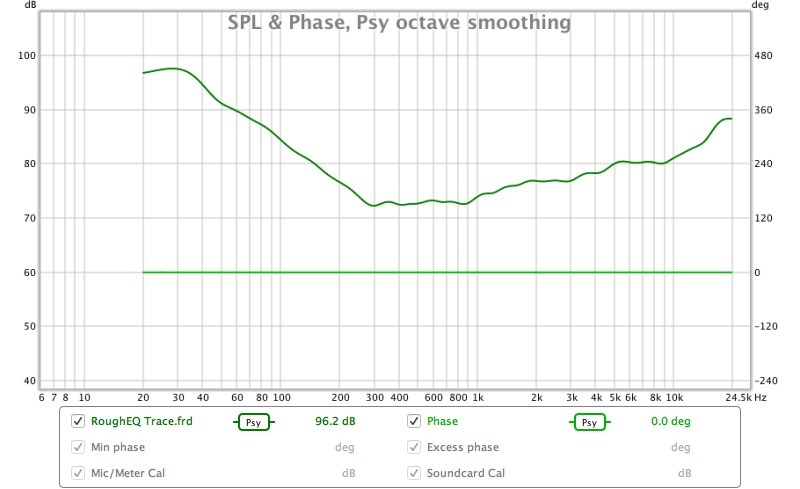
I started with an auto EQ and tweaked to get a result I liked more, seems to match pretty well. This is the graph based on Najda EQ.
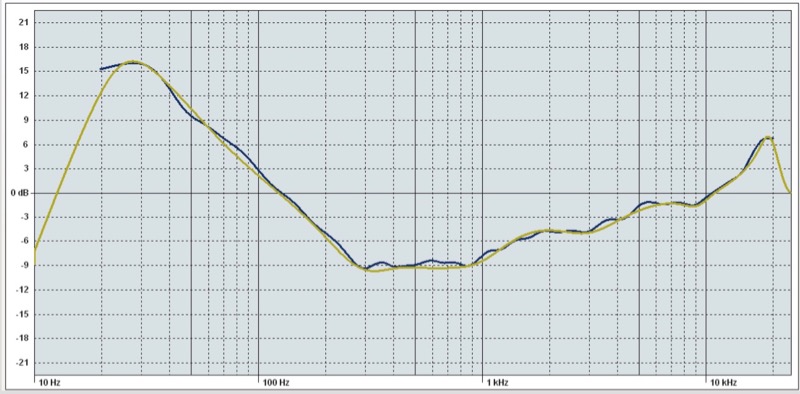
This is REW's prediction, the light red line is predicated output when the EQ is combined with an inverse of wesayso's curve.
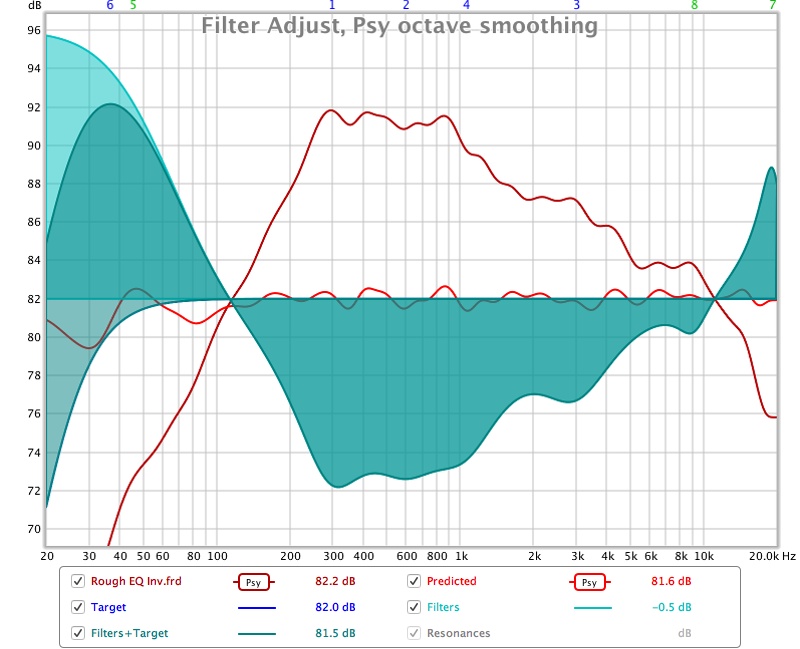
This is the analog EQ graph for the IDS-25, pretty much the same sort of shape too

I used REW's Psychoacoustic smoothing to remove most of the bumps and get a broader overall EQ that follows the trend.
I started with an auto EQ and tweaked to get a result I liked more, seems to match pretty well. This is the graph based on Najda EQ.
This is REW's prediction, the light red line is predicated output when the EQ is combined with an inverse of wesayso's curve.
This is the analog EQ graph for the IDS-25, pretty much the same sort of shape too
Attachments
You might need to adjust a bit here and there for your room but it will get you in the ball park. At least to run in the speakers. This probably already features my preferred balance and as a result wont be a flat frequency response.
Adjust it by ear for the time being based on listening and it should get you close to get a pretty good start. I remember it blew my mind when I first ran my arrays. Had a lot of fun listening.
Adjust it by ear for the time being based on listening and it should get you close to get a pretty good start. I remember it blew my mind when I first ran my arrays. Had a lot of fun listening.
You might need to adjust a bit here and there for your room but it will get you in the ball park. At least to run in the speakers. This probably already features my preferred balance and as a result wont be a flat frequency response.
Adjust it by ear for the time being based on listening and it should get you close to get a pretty good start. I remember it blew my mind when I first ran my arrays. Had a lot of fun listening.
I tend to prefer a down tilting curve myself on the dipoles so I think that will be OK for now. No doubt there will be lots of tweaking and adjusting to come but I think that this will be enough to avoid total disappointment the first time I turn them on!
I am amazed how close your curve is to Roger Russell's analogue EQ in the general trend, maybe I shouldn't be as there seems to be a lot of similarity between 25 driver arrays of Vifa drivers.
Given the level of low frequency EQ I am considering if an analogue circuit might be useful for the low boost (at least to get it in the ballpark). I have found before that anything over 15dB is pushing the limits where the gain reduction needed can have a negative effect on the sound from the DAC.
- Home
- Loudspeakers
- Full Range
- Full Range TC9 Line Array CNC Cabinet

